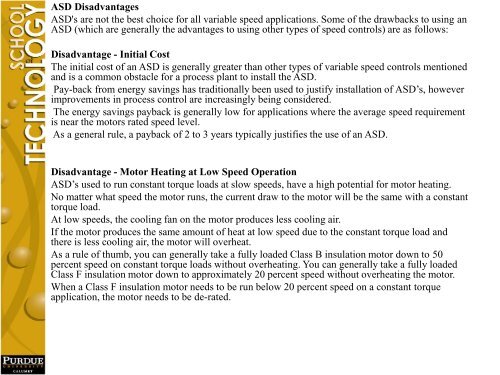Variable Frequency Drive - Purdue University Calumet
Variable Frequency Drive - Purdue University Calumet
Variable Frequency Drive - Purdue University Calumet
Create successful ePaper yourself
Turn your PDF publications into a flip-book with our unique Google optimized e-Paper software.
ASD Disadvantages<br />
ASD's are not the best choice for all variable speed applications. Some of the drawbacks to using an<br />
ASD (which are generally the advantages to using other types of speed controls) are as follows:<br />
Disadvantage - Initial Cost<br />
The initial cost of an ASD is generally greater than other types of variable speed controls mentioned<br />
and is a common obstacle for a process plant to install the ASD.<br />
Pay-back from energy savings has traditionally been used to justify installation of ASD’s, however<br />
improvements in process control are increasingly being considered.<br />
The energy savings payback is generally low for applications where the average speed requirement<br />
is near the motors rated speed level.<br />
As a general rule, a payback of 2 to 3 years typically justifies the use of an ASD.<br />
Disadvantage - Motor Heating at Low Speed Operation<br />
ASD’s used to run constant torque loads at slow speeds, have a high potential for motor heating.<br />
No matter what speed the motor runs, the current draw to the motor will be the same with a constant<br />
torque load.<br />
At low speeds, the cooling fan on the motor produces less cooling air.<br />
If the motor produces the same amount of heat at low speed due to the constant torque load and<br />
there is less cooling air, the motor will overheat.<br />
As a rule of thumb, you can generally take a fully loaded Class B insulation motor down to 50<br />
percent speed on constant torque loads without overheating. You can generally take a fully loaded<br />
Class F insulation motor down to approximately 20 percent speed without overheating the motor.<br />
When a Class F insulation motor needs to be run below 20 percent speed on a constant torque<br />
application, the motor needs to be de-rated.
















